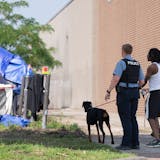The popularity of over-the-counter COVID-19 tests has blurred Minnesota's pandemic surveillance, but state officials urge people to use them to identify infections and protect others from the looming omicron wave.
State Health Commissioner Jan Malcolm said she has seen estimates that two-thirds of COVID-19 tests nationwide involve rapid antigen at-home tests purchased in pharmacies, groceries and even gas stations.
That doesn't mean that two-thirds of infections are found by at-home tests, which people often use as a precaution before visiting family and friends, she noted. But they are reducing Minnesota's count of COVID-19 cases, because the state doesn't collect at-home test results.
"We're tracking what we can, but we're mindful that it's a less and less complete picture all the time," Malcolm said. "And that's true nationally. There's a lot of conversations happening about, 'How should we be trying to measure things now?' "
The measurement concerns are emerging along with the prospect of another COVID-19 wave fueled by the fast-spreading omicron variant. Minnesota on Wednesday reported another 4,149 infections and 71 COVID-19 deaths, raising its pandemic totals to 1,049,310 infections and 10,671 deaths.
COVID-19 hospitalizations crept back to 1,405 on Tuesday after declining to 1,311 on Jan 1. The positivity rate of COVID-19 testing in Minnesota surged to 13.4% in the seven days ending Dec. 28, but that rate was inflated by the low number of people who sought testing during the holidays.
Some Minnesotans are frustrated over the lack of reporting of at-home tests. Some want to help by disclosing their results. Others have relied on the state's COVID-19 case count before deciding to travel, go into office or wear masks — even though it was always an undercount because of the number of asymptomatic people who never sought testing.
Pharmacist Jamie Hilbrands drove to seven pharmacies to find at-home tests when four of her children became ill over Thanksgiving. The Minneapolis woman didn't want them standing in line at a testing center and needed instant results ahead of a family gathering. The children's positive results aren't included in the state data.



